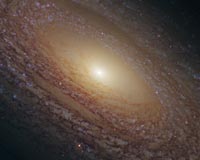 |
Paris, France (ESA) Apr 21, 2011 In celebration of the 21st anniversary of the Hubble Space Telescope's deployment into space, astronomers pointed Hubble at an especially photogenic group of interacting galaxies called Arp 273. This image, taken by the NASA/ESA Hubble Space Telescope, shows a group of interacting galaxies called Arp 273. The larger of the spiral galaxies, known as UGC 1810, has a disc that is tidally distorted into a rose-like shape by the gravitational pull of the companion galaxy below it, known as UGC 1813. The swathe of blue jewels across the top is the combined light from clusters of intensely bright and hot young blue stars. These massive stars glow fiercely in ultraviolet light. The smaller, nearly edge-on companion shows distinct signs of intense star formation at its nucleus, perhaps triggered by the encounter with the companion galaxy. A series of uncommon spiral patterns in the large galaxy are a telltale sign of interaction. The large, outer arm appears partially as a ring, a feature that is seen when interacting galaxies actually pass through one another. This suggests that the smaller companion actually dived deeply, but off-centre, through UGC 1810. The inner set of spiral arms is highly warped out of the plane, with one of the arms going behind the bulge and coming back out the other side. How these two spiral patterns connect is still not precisely known. A possible mini-spiral may be visible in the spiral arms of UGC 1810 to the upper right. It is noticeable how the outermost spiral arm changes character as it passes this third galaxy, from smooth with lots of old stars (reddish in colour) on one side, to clumpy and extremely blue on the other. The fairly regular spacing of the blue star-forming knots fits with what is seen in the spiral arms of other galaxies and can be predicted from the known instabilities in the gas contained within the arm. The larger galaxy in the UGC 1810-UGC 1813 pair has a mass that is about five times that of the smaller galaxy. In unequal pairs such as this, the relatively rapid passage of a companion galaxy produces the lopsided or asymmetric structure in the main spiral. Also in such encounters, the starburst activity typically begins earlier in the minor galaxy than in the major galaxy. These effects could be due to the fact that the smaller galaxies have consumed less of the gas present in their nucleus, from which new stars are born. Arp 273 lies in the constellation Andromeda and is roughly 300 million light-years away from Earth. The image shows a tenuous tidal bridge of material between the two galaxies that are separated by tens of thousands of light-years from each other. The interaction was imaged on 17 December 2010, with Hubble's Wide Field Camera 3 (WFC3). This Hubble image is a composite of data taken with three separate filters on WFC3 that allow a broad range of wavelengths covering the ultraviolet, blue, and red portions of the spectrum.
Share This Article With Planet Earth
Related Links Hubble Space Telescope Space Telescope News and Technology at Skynightly.com
 Hubble Shows New Image of Spiral Galaxy NGC 2841
Hubble Shows New Image of Spiral Galaxy NGC 2841Garching, Germany (ESO) Feb 18, 2011 The galaxy NGC 2841 - shown here in this NASA/ESA Hubble Space Telescope image, taken with the space observatory's newest instrument, the Wide Field Camera 3 - currently has a relatively low star formation rate compared to other spirals. It is one of several nearby galaxies that have been specifically chosen for a new study in which a pick 'n' mix of different stellar nursery environments ... read more |
|
| The content herein, unless otherwise known to be public domain, are Copyright 1995-2010 - SpaceDaily. AFP and UPI Wire Stories are copyright Agence France-Presse and United Press International. ESA Portal Reports are copyright European Space Agency. All NASA sourced material is public domain. Additional copyrights may apply in whole or part to other bona fide parties. Advertising does not imply endorsement,agreement or approval of any opinions, statements or information provided by SpaceDaily on any Web page published or hosted by SpaceDaily. Privacy Statement |